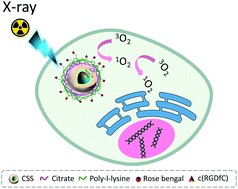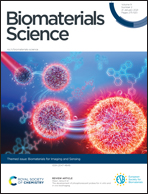Tb-Doped core–shell–shell nanophosphors for enhanced X-ray induced luminescence and sensitization of radiodynamic therapy†
Abstract
The development of radiation responsive materials, such as nanoscintillators, enables a variety of exciting new theranostic applications. In particular, the ability of nanophosphors to serve as molecular imaging agents in novel modalities, such as X-ray luminescence computed tomography (XLCT), has gained significant interest recently. Here, we present a radioluminescent nanoplatform consisting of Tb-doped nanophosphors with an unique core/shell/shell (CSS) architecture for improved optical emission under X-ray excitation. Owing to the spatial confinement and separation of luminescent activators, these CSS nanophosphors exhibited bright optical luminescence upon irradiation. In addition to standard physiochemical characterization, these CSS nanophosphors were evaluated for their ability to serve as energy mediators in X-ray stimulated photodynamic therapy, also known as radiodynamic therapy (RDT), through attachment of a photosensitizer, rose bengal (RB). Furthermore, cRGD peptide was used as a model targeting agent against U87 MG glioblastoma cells. In vitro RDT efficacy studies suggested the RGD-CSS-RB in combination with X-ray irradiation could induce enhanced DNA damage and increased cell killing, while the nanoparticles alone are well tolerated. These studies support the utility of CSS nanophosphors and warrants their further development for theranostic applications.

- This article is part of the themed collection: Biomaterials for Imaging and Sensing


 Please wait while we load your content...
Please wait while we load your content...